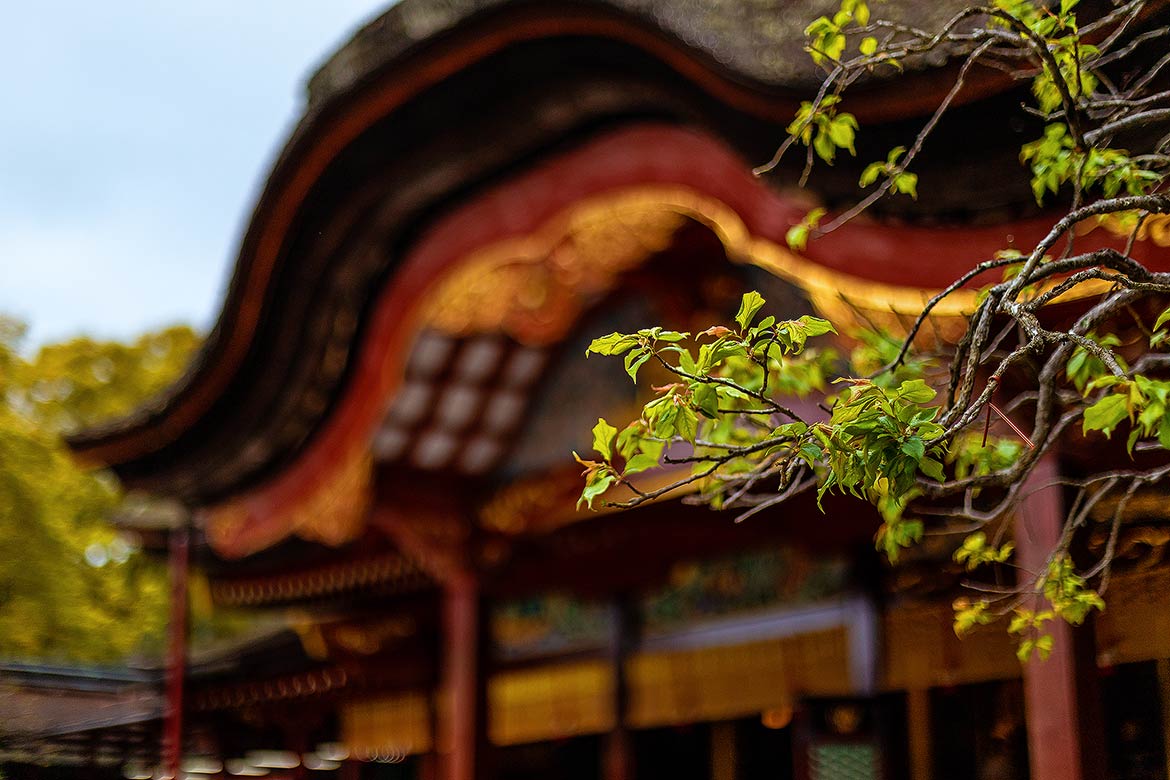Dazaifu is a small city just a short train ride from Fukuoka in the North of Kyūshū. The second part of our mini series gives you a detailed overview of the local shrines and lets you immerse yourself in their stunning beauty.
If you want to learn more about the basics of Dazaifu, including some historical information, access and public transport, read the first part of the series..
Dazaifu Tenman-gū (shrine)
The Dazaifu Tenman-gū itself is a master sample for transferring traditions into the present age. Side by side to the cultural treasures of old times, the shrine displays a diversity of contemporary art and introduces itself with a modern, modest corporate design. In a remarkable naturalness, Tenjin-sama is revered by showing what today’s art scene has to offer.
Prominent exhibit of the permanent collection installed by the Keidai Art Museum is “really shiny stuff that doesn’t mean anything” by Ryan Gander from 2011. After a short stop at the shrine information and shop, turn right and you’ll find the spherical sculpture hidden behind the lattice windows of a small building called Ukodono. The object’s metal reflects the natural light, shimmering from the heart of the subtle, dark wooden room and giving the divine space a modern glow.
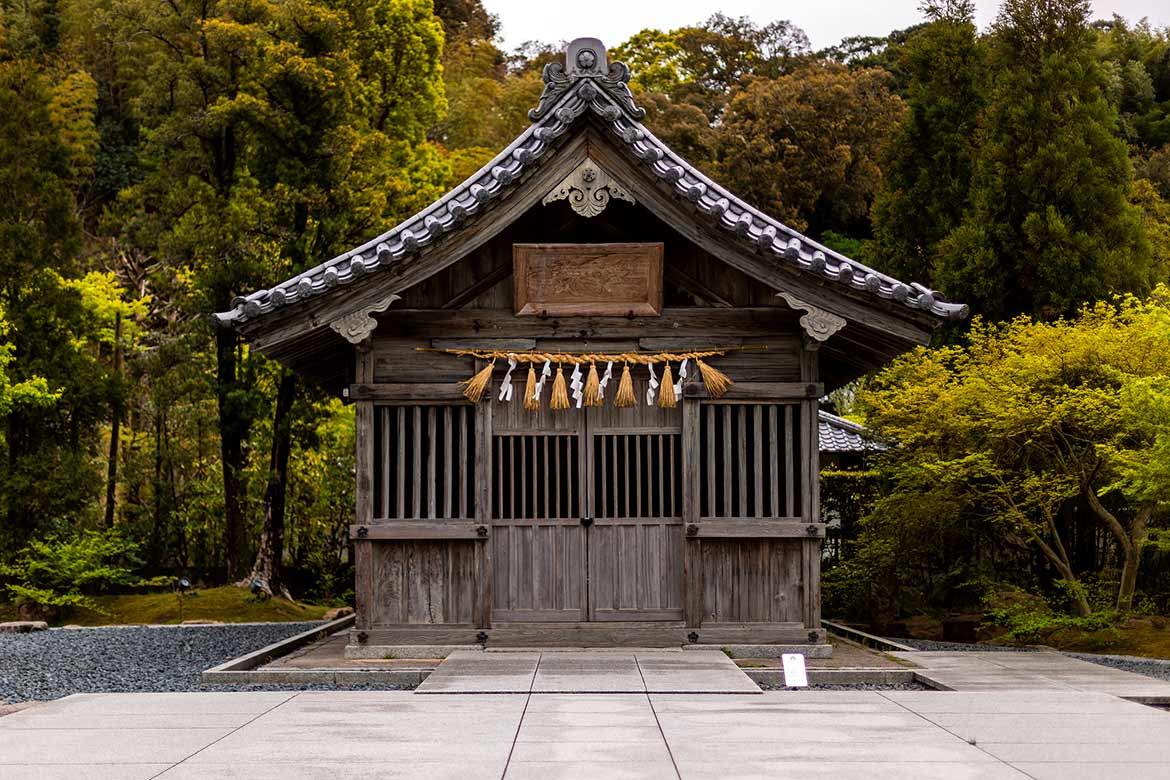
Ukodono building with Ryan Gander’s 2011 work “really shiny stuff that doesn’t mean anything” inside.
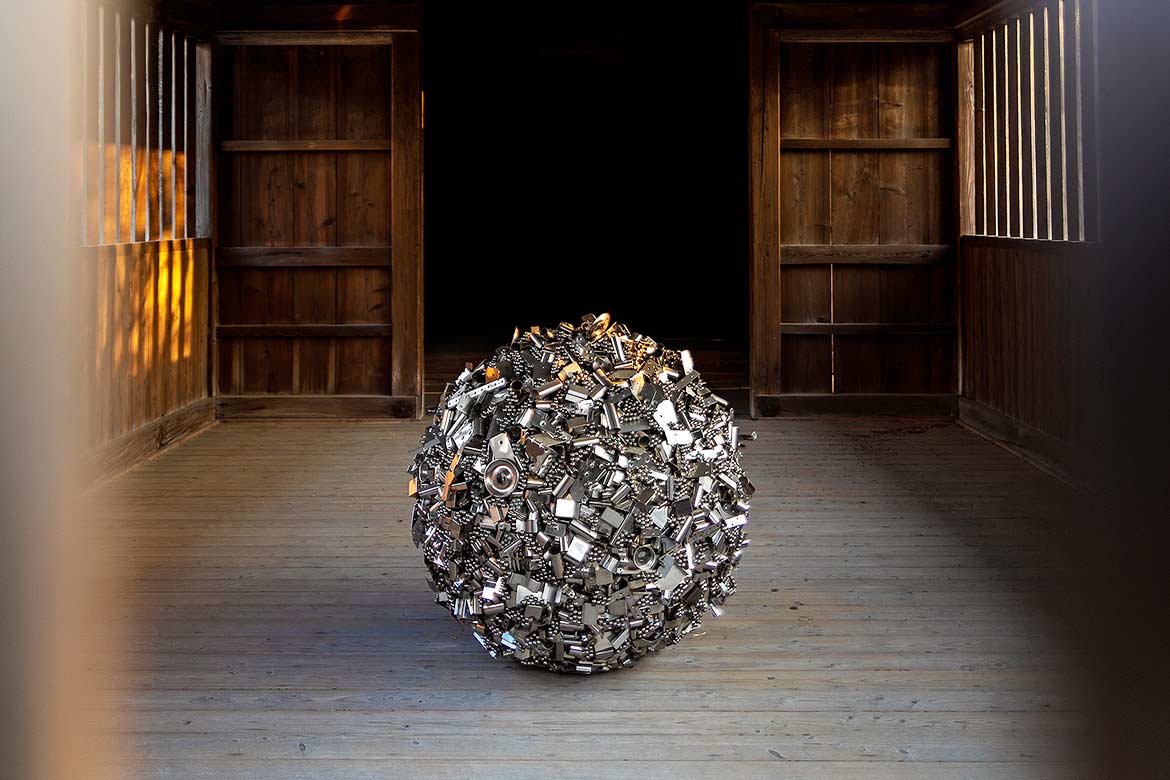
The sculpture “really shiny stuff that doesn’t mean anything” by Ryan Gander, 2011, on display by Keidai Art Museum on the grounds of Dazaifu Tenman-gū.
The Dazaifu Tenman-gū Museum, Homotsuden, at the rear side of the shrine grounds has mostly pieces of their historic collection on display, but a gallery space is used for contemporary special exhibitions. Other buildings further back towards the Kyhūshū National Museum are used for events as well.
When I visited Dazaifu in early April, 2019, a solo exhibition of artist and costume designer Kodue Hibino had just opened at the Dazaifu Tenman-gū Archive, matching the tatami rooms and light shoji doors with her whimsical, playful artworks.
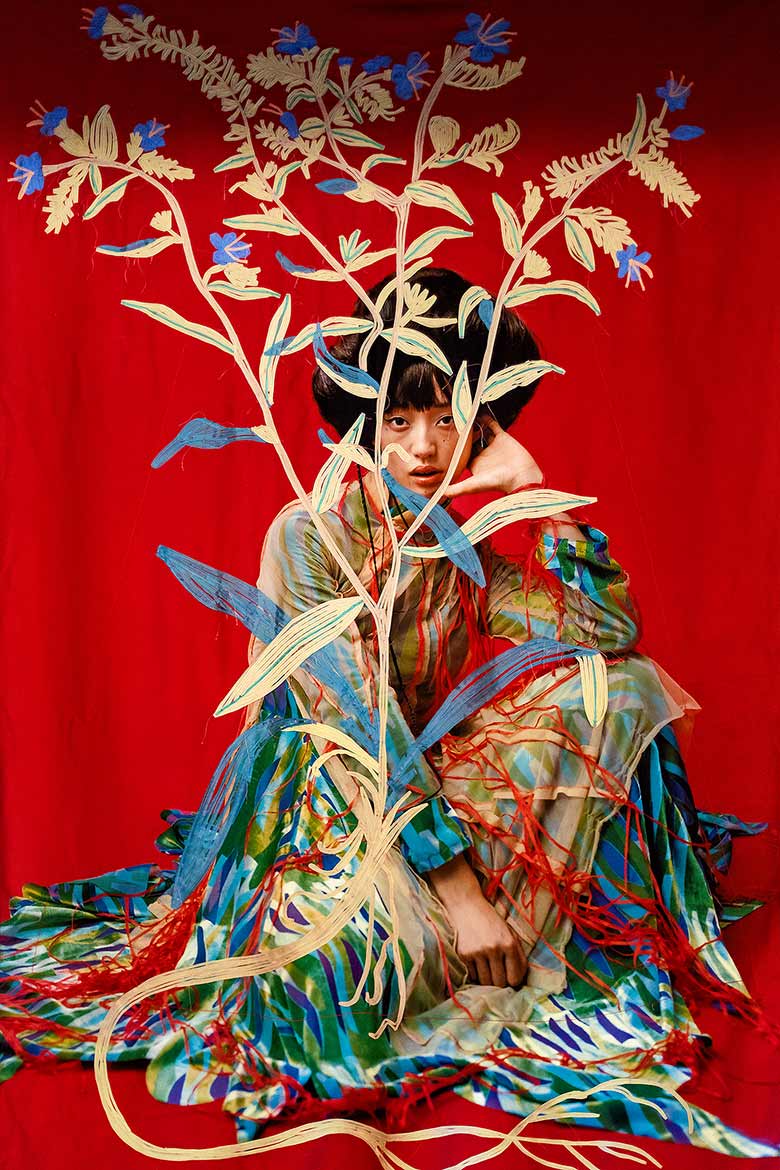
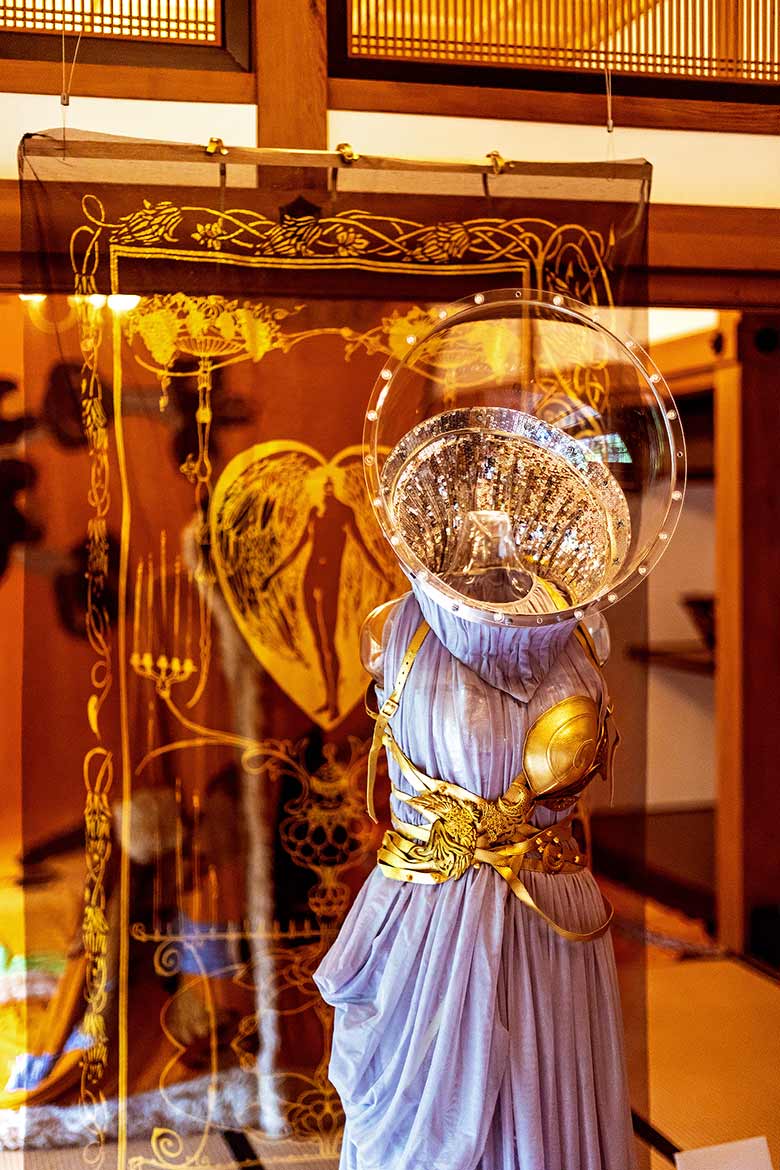
Artworks of Kodue Hibino, a costume designer and artist, on display at Dazaifu Tenman-gū Archive in April, 2019.
Naturally, visitors with a more traditional, religious, or historical interest will be fully catered as well. Heading towards the main hall, honden, you will likely tread the path over the pond Shinji-ike, passing the three parts of the bridge Taiko-bashi, which represent the past, the present, and the future.
Purify yourself at the water basin in front of the double-roofed main tower gate, rōmon, and take a peek at the statues of the mystical creature called kirin, a pair of stag and hind in grass, and one of several holy oxen, go-shingyu, on the premises. Legend has it that the ox pulling the cart with Michizane’s body in the funeral procession suddenly stopped and refused to move, forcing the funeral party to bury Michizane on spot—the space where Dazaifu Tenman-gū was later built. Patting an ox statue on the head is supposed to make you smarter and to broaden your knowledge, so why don’t you give it a try?
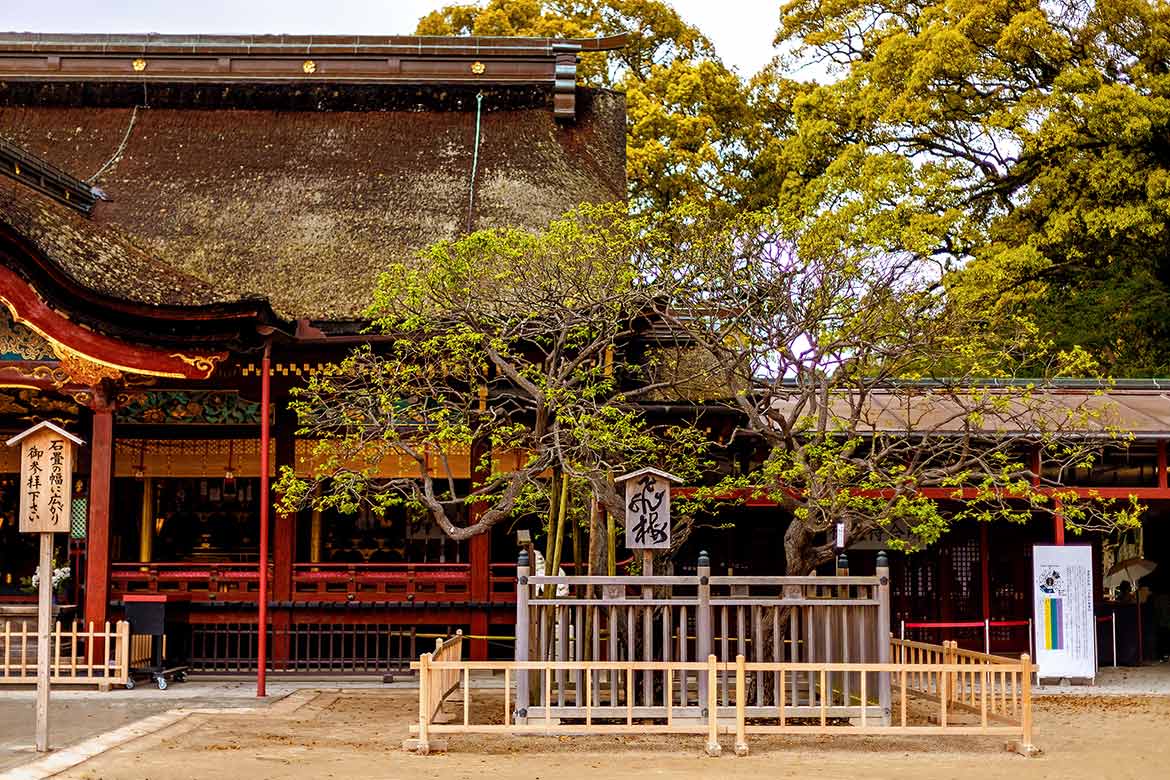
Tobi-ume, flying ume, in front of Dazaifu Tenman-gū’s main hall, which is said to has been flying from Kyōto to Dazaifu to reunite with Sugawara no Michizane.
When entering the spacious courtyard between the rōmon and the honden, you will feel the fresh air of the close-by mountains, even when it’s crowded. After making your way unhurriedly towards the center of worshipping, take a look at the ume tree on its right front. It is called Tobi-ume, flying ume, and it is said that the tree flew from Kyōto to Dazaifu to reunite with Michizane, who adored that particularly tree so much. A secular version of the story is that either Michizane himself or a friend of his transplanted its seedling.
Standing in front of the main hall, you can get lost in its colorful wood carvings, lamps, banners, and decorations. The first shrine was built here already two years after Michizane’s death by one of his trusted followers. Then in 919, the Fujiwara clan financed a larger building, which eventually burned down in one of Japan’s civil wars. The current structure was completed in 1591 during Momoyama period and is now a designated Important Cultural Property of Japan.
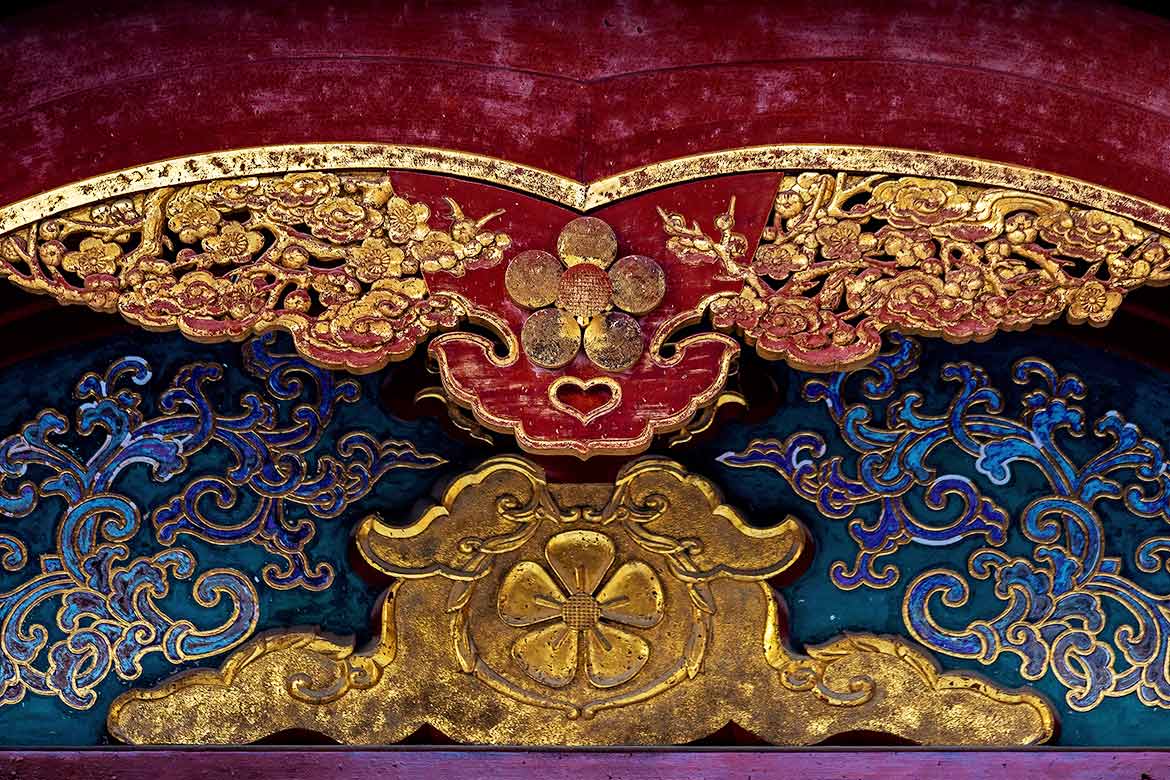
Decorations at the gable front of Dazaifu Tenman-gū’s honden or main hall. depicting ume crests and twigs, clouds, and karakusa or arabesques.
After paying your respects, head a bit further and you’ll find the Kanko Historical Museum behind the honden with dioramas about Sugawara no Michizane’s life. An English pamphlet with scene descriptions is available. Further ahead are a couple of tea houses which must be particularly appealing when all the
ume trees in this part of the shrine grounds are in full bloom.
Due to Michizane’s admiration for ume trees, Dazaifu Tenman-gū is a popular spot to watch ume blossoms with its around six thousand ume trees of almost two hundred types. They typically bloom from late February to mid March, which coincides with the announcement of exam scores. You see, it all fits together!
Tenkai Inari-sha (shrine)
Right next to Dazaifu Tenman-gū in the directions of Kamado-jinja lies Tenkai Inari-sha. After passing the ume grove, a hard to miss pathway leads you towards the first gate of the small shrine. Already while walking up the hill towards the shrine buildings, you’ll get an idea why Japanese call the Tenkai Inari-sha grounds a power spot.
The red and white flags and the for Inari shrines typical red gates called torii match perfectly with the dark greens and browns of the forest. Breathe in the fresh air and enjoy the feeling of nature in solitude or among only a few others even on days when Dazaifu Tenman-gū is packed with people.
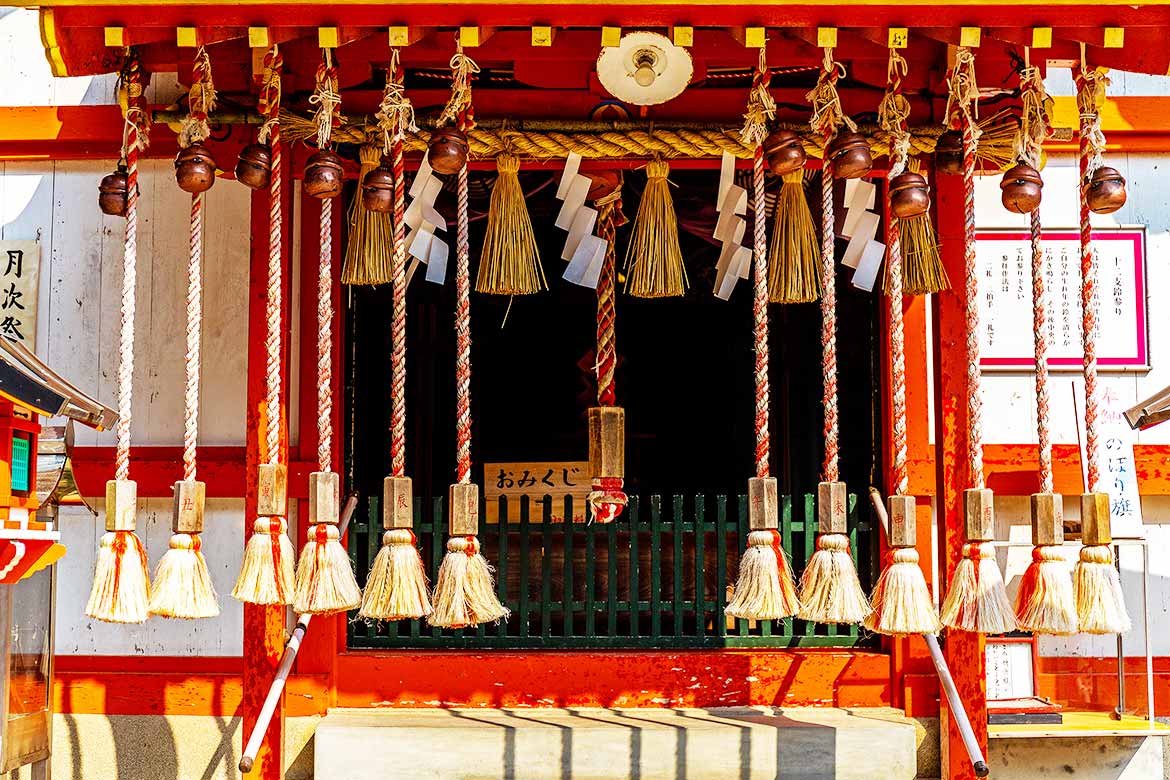
Twelve zodiac bells and one main bell in front of Tenkai Inari-sha’s main hall, honden.
Tenkai Inari-sha is rather small, but one of the oldest Inari shrines in Kyūshū, built during Kamakura era. Just like Fushimi Inari Taisha close to Kyõto, it enshrines Uka no Mitama no Kami, the deity of grain from old Japanese mythology, which became equated with Inari, the deity of rice, prosperity, business success, and good luck.
At the shrine’s main building, honden, you’ll spot its unique row of twelve bells, which are representing the twelve signs of the Chinese zodiac. When praying, devotees ring the bell of their zodiac sign first before reaching for the main bell in the center.
Turn to the left, pass the water basin, and then climb up a few further stairs to find another unique feature of Tenkai Inari-sha: A small prayer place in a stone cave called Oku no In. Also, discover the beauty of golden omikuji, fortune telling paper strips, and the strong features of the stone messenger foxes while walking around the premises.
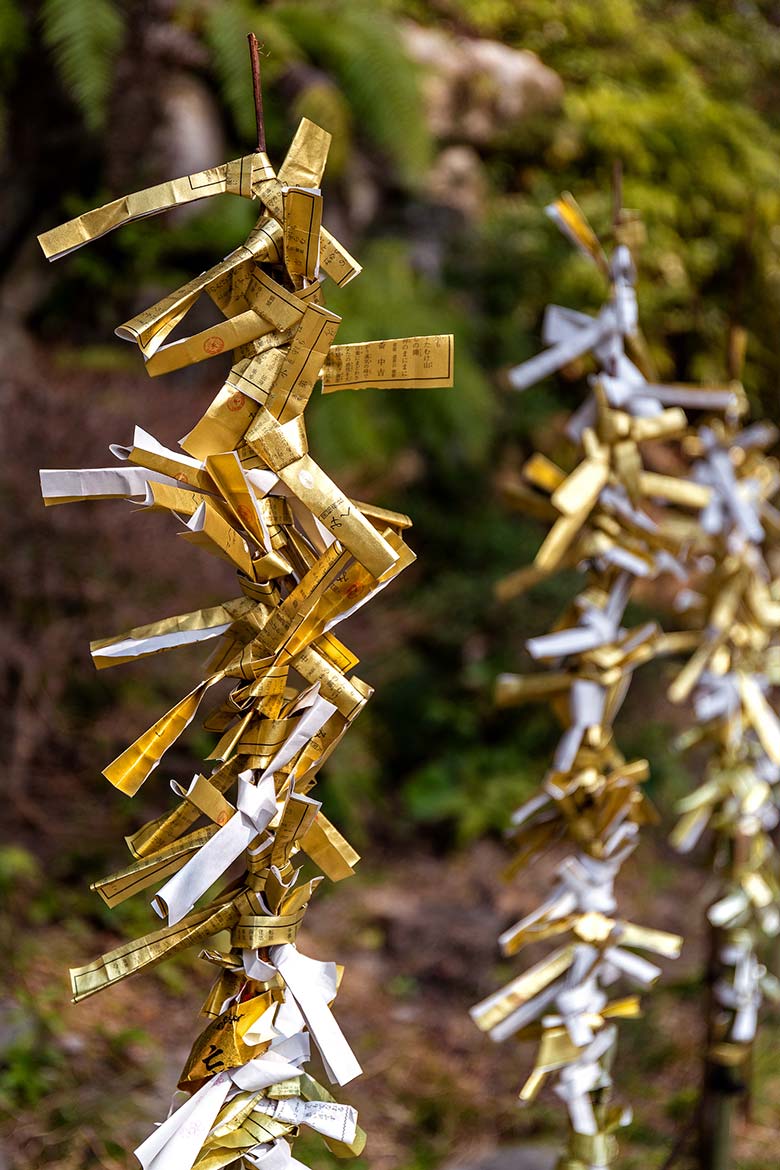
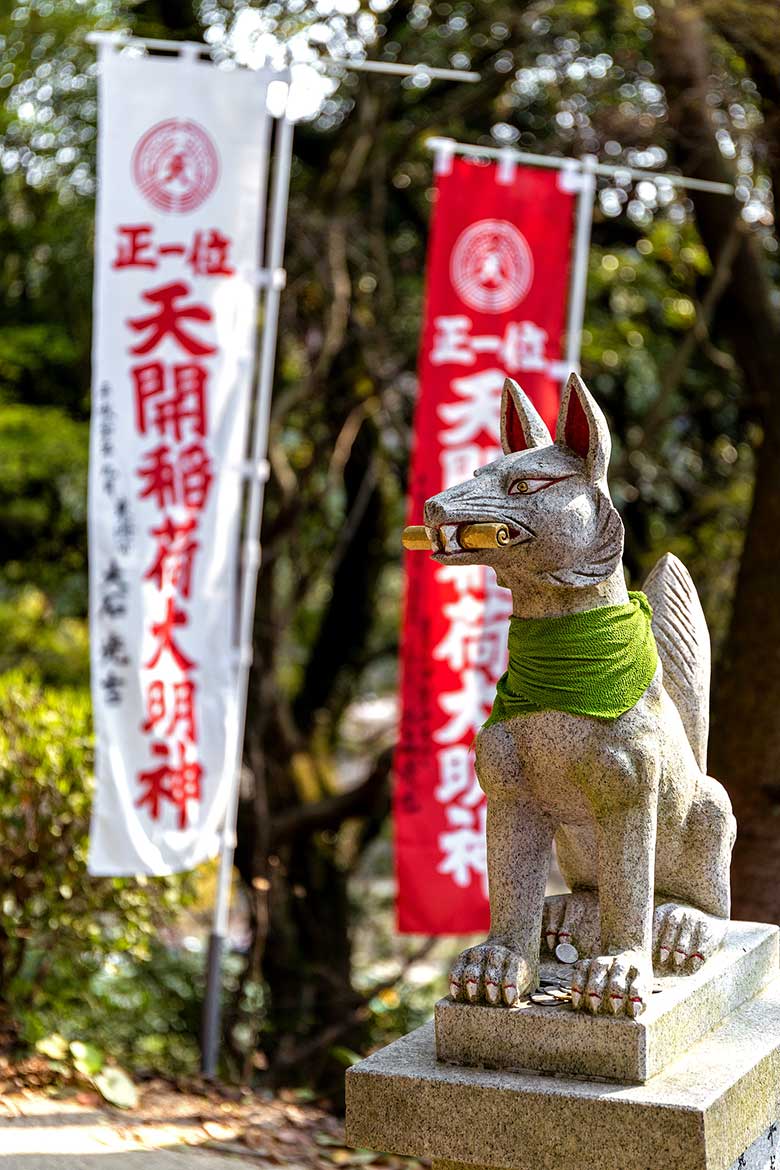
Golden omikuji, fortune telling papers, and a stone messenger fox on the grounds of Tenkai Inari-sha.
Kamado-jinja (shrine)
When visiting Dazaifu, you should also stop by Kamado-jinja further up the hills. To get there, you can either take a thirty minutes walk or head towards one of the bus stops close to Tenkai Inari-sha or at Dazaifu Station. Keep in mind that there are only about two buses per hour, but that the walk can be a bit tiring. If you’re traveling by car, you can park at the parking area in front of the shrine’s main gate.
Kamado-jinja has two sanctuaries, one at the base of the mountain Hōman-zan and one on its top. There has once been a third one between these two, of which only ruins remain today. Shrine and mountain are a National Historic Site and the trail, which is part of the Kyūshū Nature Trail, is popular among hikers, especially for witnessing the first sunrise of the year from the mountain peak.
I haven’t been at the upper sanctuary, but it is said to take about one to two hours to reach it and according to photos I’ve seen, the view must be stunningly beautiful. Yet, you will get a decent view from the observatory deck of the lower, main shrine location as well while sitting on chairs by British designer Jasper Morrison.
When arriving at Kamado-jinja’s entrance stone torii during sakura—or cherry blossom—season, you will be welcomed by a row of gorgeously blossoming cherry trees and the area must be fantastic during the season of momiji, autumn colored foliage, as well.
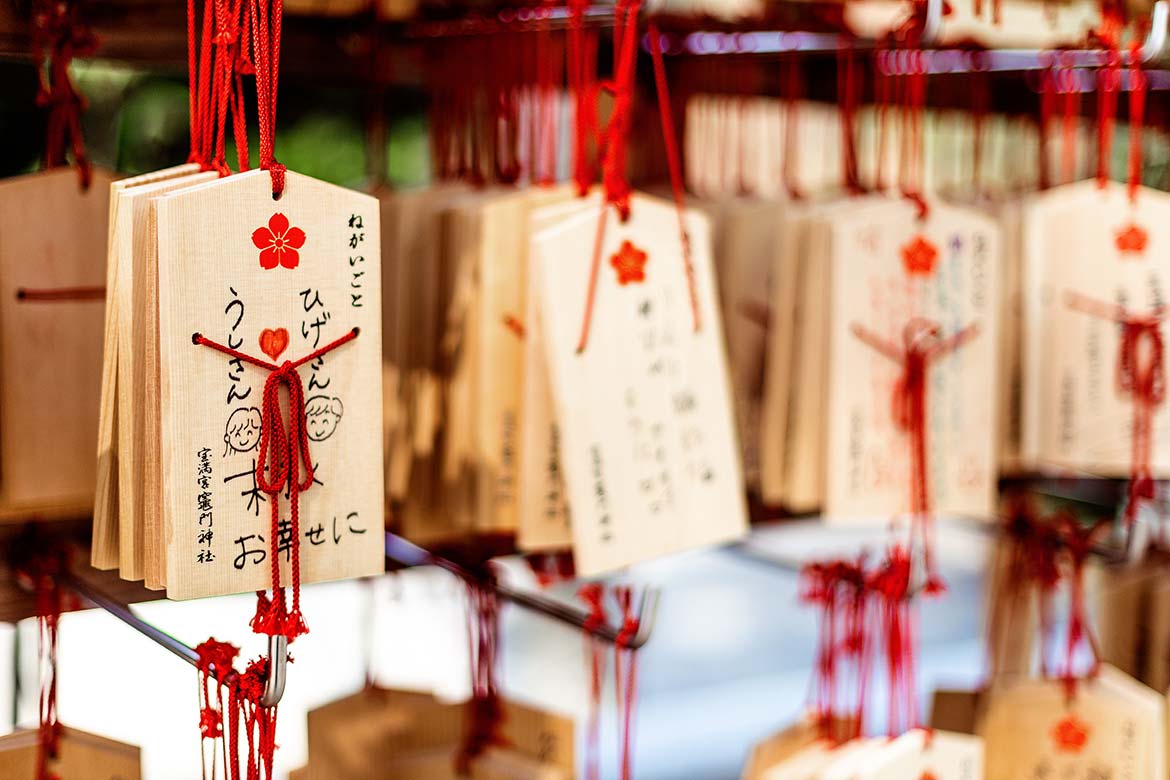
Ema, wishing plaques, from Kamado-jinja, on which couples ask for good luck in their relationship.
Located at Dazaifu’s northeastern side, which is known as an inauspicious cardinal direction called kimon, literally „demon gate“, Kamado-jinja was built in 664 to protect the governmental office against demons. Based on the ancient practice to pray here for business success and safe voyage when traveling to the Asian mainland, people of today come to Kamado-jinja to pay their respects when they have started a new life or reached a milestone.
Most of all, though, the shrine is famous for matchmaking with the main deity being Tamayori Hime no Mikoto, known as a goddess of marriage or enmusubi no kami. People who are looking for divine support in finding a spouse come here as well as couples seeking for a blessing. But even when you are not looking for romantic love, you can ask for good relationships with friends and family members, a good working environment, and even a good connection with nature.
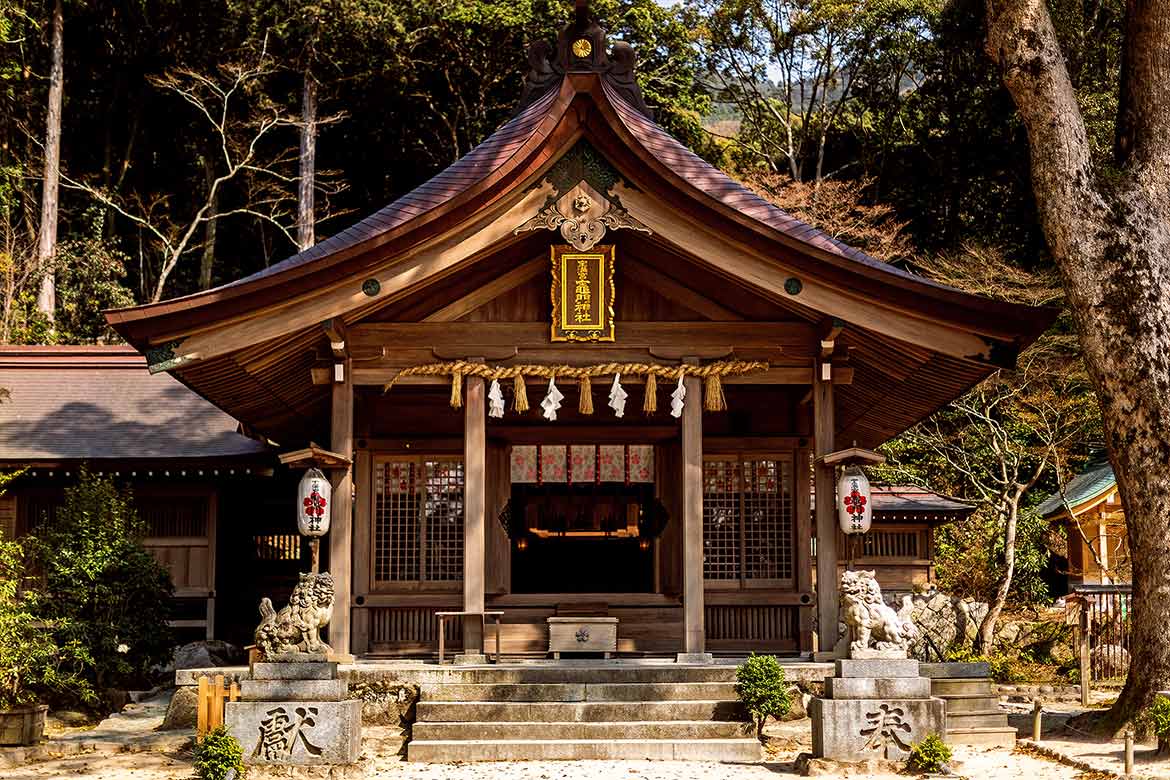
Main hall, honden, of Kamado-jinja with a newly built, small shrine on the right side.
The humble main building lies straight ahead when you have reached the main shrine’s plateau. Its weatherbeaten wooden construction is unpainted and decorated with some modest carvings and metalworks while the inner sanctuary is arcanely lid by a few lamps. If you haven’t found the peace of the place before, you have now.
In spring 2019, small enshrinements were just renewed and still had their smell of fresh wood. The golden applications reflected the sunlight insanely and one couldn’t really decide, whether these new, shining structures were more appealing or the aged appearance of the main building.
You’ll find a well-fitting contrast to these traditional constructions in the visitor’s center, juyosho, a modern building, which was designed by Masamichi Katayama of Wonderwall and opened in 2012. Enter its light-flooded amulet office to get good luck charms and ema, wooden plaques to write wishes on in request to the gods, while being amazed by the room’s contemporary chic.
Linked to the nickname of the surrounding land, Kamado-yama, which translates into „cooking hearth mountain“, the office centers around a round table as an adaption of a „hearth surrounded by an earthen floor”, as the architectural plans outline. Marble tiles in pale shades of pink give the space a warm, loving feeling and the wall behind the counter as well as the ceiling are decorated with the shrine’s crest: A sakura flower.
To write wishes on your ema, you can approach one of the small desks with felt pens in various colors. Standing there almost gives you a feeling of being in a stylish stationery shop. But you are still at the beautiful Kamado-jinja with its sublime atmosphere.
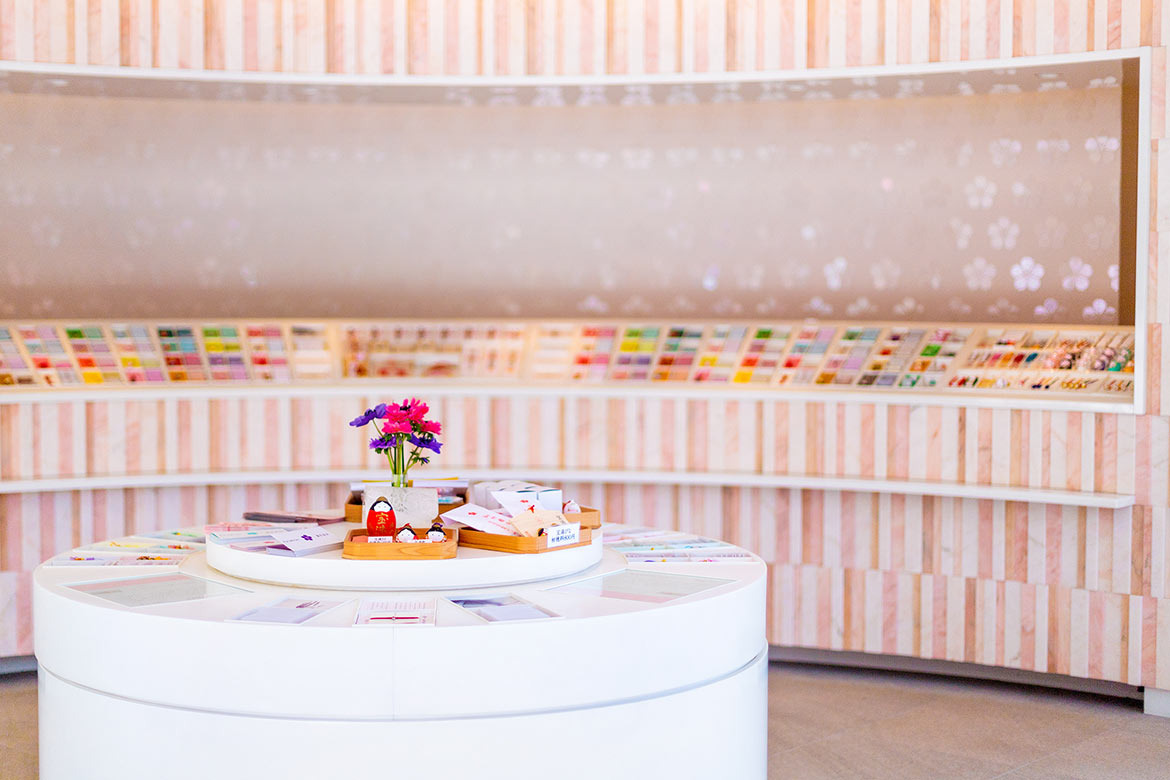
The amulet office of Kamado-jinja, designed by Masamichi Katayama of Wonderwall with a hearth symbolizing round table in the center.
Learn about Dazaifu’s further spots like the Kyushu National Museum in the upcoming third and last part of this mini series.

